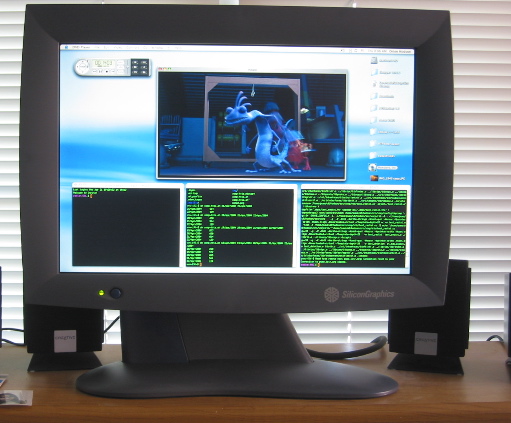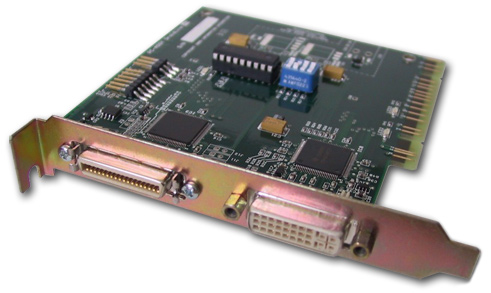
There's a new card that provides MultiLink Adapter functionality designed by members of the original 1600SW development team. The card makes the 1600SW compatible with many modern graphics card. This page provides some background info on the 1600SW, provides some info on the card, and support options.
I've bought this card and used it in conjunction with my G5 PowerMac with the NVidia GeForce FX 5200 controller at home. It's wonderful! Since this is a really cost effective way of getting an excellent display I've put this web page together to let others know.

The SGI 1600SW was an outstanding display when it was released by SGI and is still very good by today's standards. The monitor supports 24-bit 1600x1024 resolution at 110 dpi. (See article about the display).
SGI stopped selling the 1600SW a couple of years back, and today they can be bought on eBay for around $300US. The displays were designed before DVI became standardized and use a proprietary LVDS digital signalling scheme and connector. There are no cards in production that still support the hardware and those that can be bought off of eBay are several years behind the cutting edge.
Until today the only option to work with more recent graphics cards has been to buy the SGI MultiLink Adapter. The MultiLink Adapter converts between DVI and LVDS and allows graphics cards with DVI interfaces and that support the wide-display to work with the 1600SW. These originally retailed for around $500US and today sell for upwards of $600 on E-bay. This is twice the cost of the display and makes the total package cost around $900US. This might make you wince as the 20-inch Apple Cinema display retails for $1300US and offers a similar resolution and aspect ratio.

The GFX-1600SW provides similar functionality to the SGI MultiLink Adapter - it converts DVI-Digital (DVI-D) and Digital Flat Panel (DFP) to the LVDS digital interface of an 1600SW. This is very, very cool! The card rests in a PCI slot on your PC or Mac (or other PCI-bus equipped machine) and draws its power from the bus to run the converter hardware. The converter does present itself as a PCI device on the bus and so requires no drivers. The converter is completely transparent to the host so should work with any host operating system on (FreeBSD, Linux, Windows, Mac OS X, etc) as long as the hosts graphics adapter and driver is capable of the appropriate display modes.
The adapter is developed by Dan Evanicky, who headed the engineering team responsible for the 1600SW, and Oscar Medina. The card is distributed as th GFX-1600SW by Sharper Technology.
|
Some recent laptops have DVI outputs. I tested an Apple Powerbook with the GFX-1600SW and 1600SW and found it worked fine when connected -- when it was disconnected, the screen didn't immediately revert back to the usual display, but did eventually get there.
VillageTronic and Margi sell adapters than support DVI/DFP which can be used in conjunction with the GFX-1600SW and 1600SW. The VillageTronic VTBook appears to have the edge in terms of specs at the time of writing.
Dan Evanicky purchased all of Mitsubishi Japan's remaingin 1600SW inventory and bought out one of the European Service Depots. He has brand new monitors, complete display modules, backlight lamps, and many other spare parts. Dan also sells refurbished units with a 1-year warranty and will replace the backlight CCF tubes to restore the brightness and chromaticity characteristics back to their original quality.
You can reach Dan via email devanicky sbcglobal.net.
sbcglobal.net.
Most of the information on this page comes from Dan Evanicky. Dan was the technical lead on the SGI 1600SW and who provided much of the information on this page and was the technical lead on the SGI 1600SW project.
 blakespot.com
blakespot.com
* Caveat Emptor: before buying the card, check that the host graphics adapter and driver is capable of displaying the appropriate display modes.
Content last modified: July 2006
Page pulled from archive.org cache and placed at Byte Cellar (orig page 404's): February 2008
Thanks to 'Orion' who created this page...wherever you are...